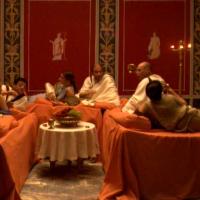-
The market (dialogue takes place in 123 a.C)
Nutrition during the Roman age was based in grains, wine and oils in addition to legumes, other vegetables and fruits, cheese and salted meats, often acquired via trade within diferent provinces of the empire. Although most diets tended to be frugal, more elaborate recipes made an appearance on special occasions.
-
 Education and marriage (123 a.C.)
Education and marriage (123 a.C.)Education was very important for the Romans. Under the harsh guidance of teachers, sons of the more comfortable classes learned mathematics as well as to read and write. Beginning at age 12, boys could receive training in more specific disciplines, such as public speaking. More wealthy families often hired private tutors, who occasionally also instructed daughters, normally in the fine arts. Usually, however, young girls were directed toward managing domestic affairs.
-
 Politics (123 a.C.)
Politics (123 a.C.)Public affairs in Valencia, as in any Roman city, were managed by the Curia and the Senate and by the magistrates, who were divided into duonviros, councillors, quaestors, and censorials. Only members of the wealthiest families could aspire to join the magistrature, as they often won public favor with their wealth by funding public entertainment and public works.
-
 Imperial Valentia (123 a.C.)
Imperial Valentia (123 a.C.)Between the first and second centuries Valentia developed a wide-reaching urban program that transformed the city's image. A new forum, or public plaza, was erected, beside which sat the Curia, the seat of the senate, and the Basilica, where commercial transactions were carried out and justice was administered. Public temples and monuments were built. An aqueduct took water from the Turia to the same city center, to the south of which a circus was constructed, where chariot races took place, the preferred spectacle of the public.
-
 The Gods (123 a.C.)
The Gods (123 a.C.)The Romans liked to showcase their religiosity and demonstrate their devotion to the gods through rituals and offerings of all types. The Roman pantheon, derived from the Greek one, was notably eclectic, as it not only incorporated indigenous deities from each newly annexed territory, but because on occasion these deities reached massive followings throughout the empire. This applies, for example, to Isis, a goddess for Egyptian origin who had many followers in Rome as well as here in Valencia. With polytheism as its base, religious tolerance was one of the pillars by which Romanization was supported.

